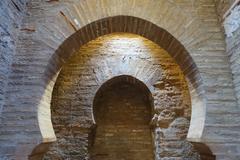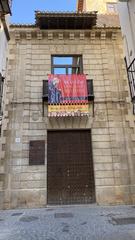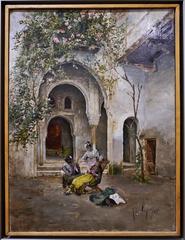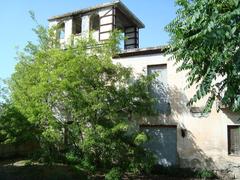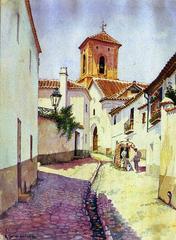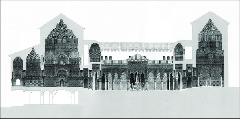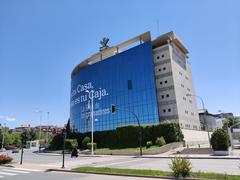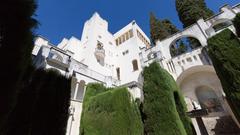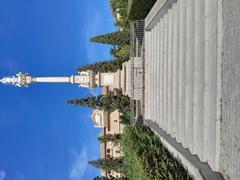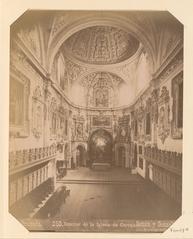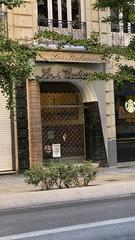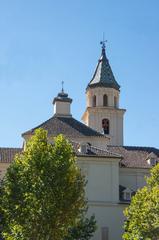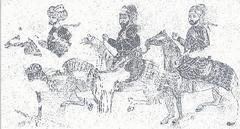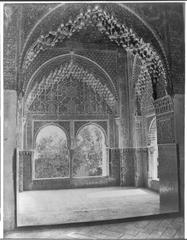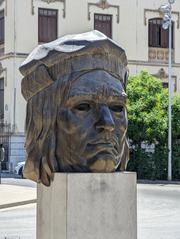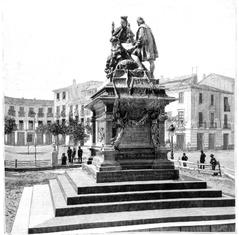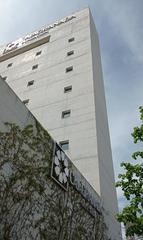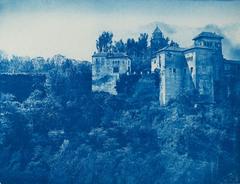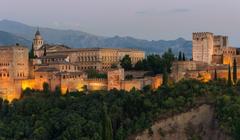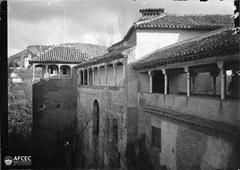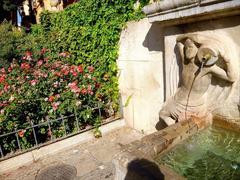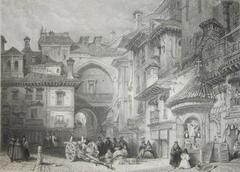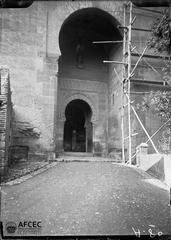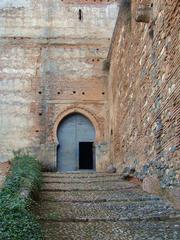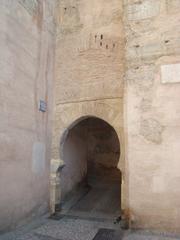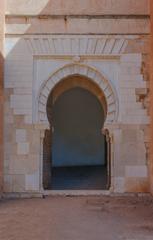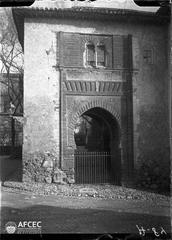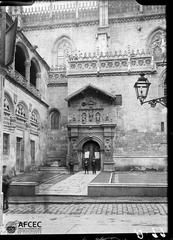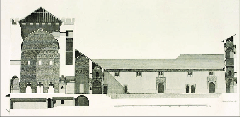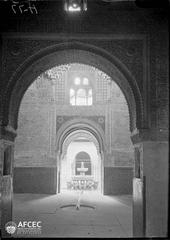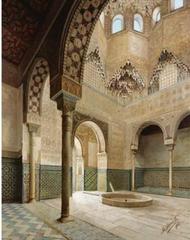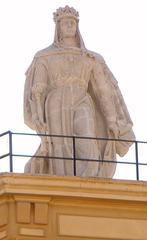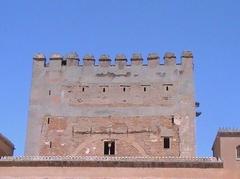Ethnological Museum of the Gypsy Woman Granada: Visiting Hours, Tickets, and Travel Guide
Date: 14/06/2025
Introduction
Located in the heart of Granada’s historic Sacromonte district, the Ethnological Museum of the Gypsy Woman (Museo Etnológico de la Mujer Gitana) is a unique cultural institution dedicated to the preservation and celebration of Romani (Gypsy) heritage, with a special focus on the pivotal role of Romani women. Housed within traditional cave dwellings—a hallmark of Sacromonte’s landscape—the museum offers an immersive experience into the daily lives, artistry, and social contributions of Gypsy women, whose stories have long been marginalized in mainstream history. Founded by the ROMI Association of Gypsy Women in 2006, the museum’s mission is not only to exhibit but also to educate, advocate, and empower, using reconstructed domestic spaces, traditional costumes, flamenco heritage, and personal testimonies that highlight both resilience and creativity (Exclusive Granada, Cicerone Granada, romheritage.eu).
Museum Significance
The museum is situated within the emblematic Sacromonte caves, which have served as homes for the Roma community since the 15th century. These cave houses not only reflect centuries of adaptation and artistry but are also deeply intertwined with flamenco and the zambra dance, hallmarks of Granada’s cultural identity (Andalucia Mia, Andalucia360Travel). Through its thoughtfully curated exhibitions, the museum invites visitors to explore domestic life, artistic expression, and communal roles, all enriched by educational programs and occasional live performances.
For those interested in Andalusian history, flamenco, and Roma culture, this museum is an essential destination that complements nearby attractions such as the Alhambra, Albaicín, and the Sacromonte Caves Museum (Rick Steves).
Contents
- Introduction
- Historical Context and Roma Community in Granada
- The Museum: Origins, Mission, and Cultural Value
- Exhibitions and Collections
- Visiting Hours, Tickets, and Location
- Visitor Experience and Accessibility
- Educational Programs and Events
- Nearby Attractions
- Frequently Asked Questions (FAQ)
- Summary & Travel Tips
- Official Sources
Historical Context: The Roma in Sacromonte
The Roma, or Gitanos, began arriving in Granada in the 15th century, settling in the Sacromonte district after the fall of the last Muslim stronghold in Spain. The area’s soft hills allowed for the creation of cave dwellings, which became central to Roma identity and daily life (Rick Steves, Go2Alhambra, Andalucia Lovers). Over centuries, Sacromonte developed into a vibrant community renowned for its flamenco and zambra traditions—a unique form of flamenco performed in the caves and shaped by the contributions of Roma women (Travel Choreography).
While the Roma community has faced historical marginalization, their resilience endures through the preservation of traditions and the flourishing of flamenco culture, now recognized and celebrated across Granada (Granada Turismo).
The Museum: Origins, Mission, and Cultural Value
Origins:
Founded in 2006 by the ROMI Association of Gypsy Women, the museum is housed in interconnected caves within the La Chumbera complex. Its purpose is to safeguard the intangible heritage of the Roma, especially highlighting the lives and achievements of women (Exclusive Granada).
Mission:
- Cultural Preservation: Collects and displays oral histories, artifacts, and personal testimonies.
- Education: Offers guided tours, school programs, workshops, and multimedia resources for deeper understanding.
- Social Advocacy: Provides a platform for Roma voices and advocates for intercultural dialogue and inclusion (romheritage.eu).
Cultural Value:
The museum is a vital part of Granada’s cultural landscape, complementing other sites such as the Sacromonte Caves Museum and Abbey of Sacromonte (The Wildlife Diaries).
Exhibitions and Collections
Permanent Exhibitions
- Domestic Life:
Faithfully reconstructed cave rooms—sleeping quarters, kitchen, and weaving areas—showcase traditional bedding, textiles, utensils, and a loom, emphasizing the central role of women in family and community life (Andalucia Mia). - Traditional Crafts:
Tools and utensils such as agricultural implements, hand mills, and weaving looms demonstrate self-sufficiency and craftsmanship. - Flamenco and Zambra:
Costumes, musical instruments, and archival photographs reveal the roots and evolution of flamenco and zambra, with a focus on women as both preservers and innovators (Cicerone Granada).
Temporary and Rotating Exhibitions
- Thematic displays on Roma wedding traditions, culinary heritage, and contemporary women’s roles.
- Collaborative projects with schools and cultural organizations, presenting research and oral histories (Andalucia360Travel).
Visiting Hours, Tickets, and Location
- Hours:
Tuesday to Sunday, 10:00 AM – 6:00 PM (last admission 5:30 PM). Closed Mondays and public holidays. Always check the official website for updates. - Tickets:
General admission €5, with discounts for students, seniors, and groups. Children under 12 enter free. Tickets can be purchased on-site or online; advance booking is recommended during peak seasons. - Location:
Cueva de la Rocío, Calle San Miguel Bajo, Sacromonte, Granada. Accessible by foot (20-minute walk from Plaza Nueva), by bus (lines 31 and C3), or taxi. There is limited parking for visitors with disabilities.
Visitor Experience and Accessibility
- Guided Tours:
Offered in multiple languages, guided tours provide deeper insights and can be booked in advance. - Workshops and Events:
Workshops in crafts and flamenco are available, alongside occasional live performances. - Accessibility:
While staff strive to assist visitors with mobility needs, the cave architecture involves uneven surfaces and steps; contact the museum for specific accommodations. - Photography:
Permitted but visitors should be sensitive, especially around personal testimonies and private artifacts.
Educational Programs and Events
The museum offers:
- School outreach and educational workshops.
- Collaborations with local and international cultural organizations.
- Participation in European projects like ROMHERITAGE, promoting the preservation of Romani heritage (romheritage.eu).
Nearby Attractions
Enhance your visit by exploring:
- Sacromonte Caves Museum: Learn more about cave living and flamenco origins.
- Abbey of Sacromonte: Historical religious center.
- Albaicín: UNESCO-listed Moorish quarter.
- Alhambra: Granada’s world-famous palace and fortress complex (espanaguide.com).
Frequently Asked Questions (FAQ)
Q: What are the museum’s opening hours?
A: Tuesday to Sunday, 10:00 AM to 6:00 PM (last admission 5:30 PM). Closed Mondays and holidays.
Q: How much are tickets?
A: €5 for adults, with discounts available; children under 12 free.
Q: Is the museum accessible to people with disabilities?
A: Accessibility may be limited due to cave architecture; contact the museum for assistance.
Q: Are guided tours and workshops available?
A: Yes, both are offered and recommended for a richer experience.
Q: How do I get there?
A: On foot from central Granada, by bus (lines 31 and C3), or by taxi. Wear comfortable shoes due to hilly terrain.
Summary & Travel Tips
The Ethnological Museum of the Gypsy Woman is a cornerstone of Granada’s cultural landscape, illuminating the history, artistry, and resilience of the Roma community—particularly women. Its immersive exhibitions and educational programs foster understanding, support social advocacy, and help preserve traditions for future generations (Exclusive Granada, romheritage.eu, Andalucia360Travel). Plan your visit in advance, check official sources for the latest information, and take advantage of workshops and cultural events for a truly enriching experience.
Sources and Further Information
- Rick Steves – Granada’s Sacromonte District
- Cicerone Granada – Sacromonte Caves
- Exclusive Granada – Museum of the Gypsy Woman
- Espanaguide – Sacromonte
- Romheritage.eu – Museum Profile
- Andalucia360Travel – Museums of Granada
- Andalucia Lovers – Best Museums in Granada
- The Wildlife Diaries – Sacromonte Caves
Image suggestions with alt text:
- “Ethnological Museum of the Gypsy Woman facade”
- “Traditional Romani dress exhibit”
- “Flamenco performance at the museum”
- “Map showing location of museum in Sacromonte”
- “Panoramic view of Alhambra from museum”
- “Visitors participating in flamenco workshop”
For more on Granada’s historical sites and flamenco culture, see our related articles.

